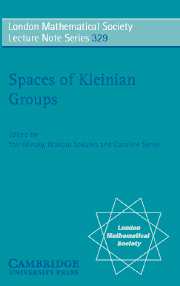Book contents
- Frontmatter
- Contents
- Preface
- Drilling short geodesics in hyperbolic 3-manifolds
- On topologically tame Kleinian groups with bounded geometry
- An extension of the Masur domain
- Thurston's bending measure conjecture for once punctured torus groups
- Complexity of 3-manifolds
- Moduli of continuity of Cannon–Thurston maps
- Variations of McShane's identity for punctured surface groups
- Train tracks and the Gromov boundary of the complex of curves
- The pants complex has only one end
- The Weil–Petersson geometry of the five-times punctured sphere
- Convexity of geodesic-length functions: a reprise
- A proof of the Ahlfors finiteness theorem
- On the automorphic functions for Fuchsian groups of genus two
- Boundaries for two-parabolic Schottky groups
- Searching for the cusp
- Circle packings on surfaces with projective structures: a survey
- Grafting and components of quasi-fuchsian projective structures
- Computer experiments on the discreteness locus in projective structures
Searching for the cusp
Published online by Cambridge University Press: 05 November 2011
- Frontmatter
- Contents
- Preface
- Drilling short geodesics in hyperbolic 3-manifolds
- On topologically tame Kleinian groups with bounded geometry
- An extension of the Masur domain
- Thurston's bending measure conjecture for once punctured torus groups
- Complexity of 3-manifolds
- Moduli of continuity of Cannon–Thurston maps
- Variations of McShane's identity for punctured surface groups
- Train tracks and the Gromov boundary of the complex of curves
- The pants complex has only one end
- The Weil–Petersson geometry of the five-times punctured sphere
- Convexity of geodesic-length functions: a reprise
- A proof of the Ahlfors finiteness theorem
- On the automorphic functions for Fuchsian groups of genus two
- Boundaries for two-parabolic Schottky groups
- Searching for the cusp
- Circle packings on surfaces with projective structures: a survey
- Grafting and components of quasi-fuchsian projective structures
- Computer experiments on the discreteness locus in projective structures
Summary
Abstract
We discuss the process of algebraically finding cusps on the boundaries of deformation spaces of kleinian groups. The geometric starting point is an arrangement of circles with prescribed tangencies and relationships under a set of Möbius transformations. These lead to polynomial equations in several complex variables, which may then be numerically solved for the values which describe the cusp. We will go through this process for several deformation spaces corresponding to “plumbing” constructions of Maskit and Kra, and we will present some of the numerical output. The same techniques can also be used to calculate the coherent spiral hexagonal circle packings discovered by Peter Doyle, and we will compare the similarity factors of those packings to cusps on boundaries of deformation spaces.
Introduction
In this paper, we study the theoretical and numerical calculation of maximal cusp groups on the boundary of deformation spaces of kleinian groups. Specifically, we are interested in maximally parabolic groups which allow no deformations with a greater number of classes of parabolic elements.
The foundational study of cusp groups occurred in Bers' paper [Ber70] on boundaries of Teichmüller spaces. There he proved that the cusp groups form a set of measure zero in the boundary, and that there exist boundary groups he termed totally degenerate, for which the ordinary set is a single invariant domain. Then came a windstorm of ideas from Thurston, first in his celebrated Geometry and Topology of 3-Manifolds and then in many subsequent talks and notes [Thu80, Thu82, Thu89, KT90].
- Type
- Chapter
- Information
- Spaces of Kleinian Groups , pp. 301 - 336Publisher: Cambridge University PressPrint publication year: 2006
- 1
- Cited by



